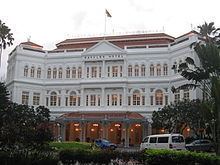Founded 1892 | ||
 | ||
Swan and Maclaren Architects is the oldest architectural firm in Singapore. Formerly known as Swan and Maclaren, it was the most prominent architectural firm in Singapore when Singapore was a British colony in the early 20th century.
Contents
Early history
The company began as Swan and Lermit in 1887, a civil engineering firm formed by two surveyor engineers. In 1892, it became Swan and Maclaren, after Lermit withdrew and another surveyor engineer, James Waddell Boyd Maclaren, joined as partner.
Rise to prominence
In 1897, Regent Alfred John Bidwell (1869–1918) joined the firm, arriving in Singapore from England after a short working stint at the Public Works Department in Kuala Lumpur of the Federated Malay States. He was the first professionally trained architect in Singapore since George Drumgoole Coleman had practised in the town in the 1820s and 1830s. Bidwell found an opportunity in Singapore to exercise his knowledge of the full range and variety of Western architectural vocabulary.
Because of Bidwell's talent and reputation for designing handsome government buildings, Swan and Maclaren became the dominant architectural firm in colonial Singapore. Bidwell dominated its work between 1897 and 1911. The firm proceeded to win the most prestigious commissions in Singapore, and many of its early buildings are still extant today. Some of these buildings have been gazetted as national monuments, and these include Raffles Hotel (1899), Teutonia Club (1900, now Goodwood Park Hotel) and Victoria Memorial Hall (1905, now Victoria Theatre and Concert Hall).
The Raffles Hotel was one of the first of the numerous projects by Bidwell under Swan and Maclaren, which was to build a substantial number of buildings in a large variety of architectural styles. The firm was commissioned to rebuild the Teutonia Club in 1900 in its new location on Scotts Road, after it moved from its location near Raffles Hotel on North Bridge Road. Bidwell applied the south German architectural style in his design of the clubhouse. In Singapore's downtown area, Bidwell also designed the three-storey Stamford House (formerly known as the Oranje Building), completed in 1904.
By 1904, Swan and Maclaren was the largest architectural firm in Singapore. In 1905, Swan and Maclaren worked on the extensions and rebuilding of the Victoria Memorial Hall. In the same year, the Chesed-El Synagogue on Oxley Rise was built. In 1907, the Singapore Cricket Club was extended and refurbished, and the 'Eastern Extension' (later 'Telegraph House', today Sofitel 'So Singapore) on 35 Robinson Road was constructed. In that year, the firm also designed and built one of the largest shops in early Singapore, the John Little department store in Raffles Place, located on the opposite side of the square from Robinson and Company. Between 1906 and 1912, Swan and Maclaren rebuilt the Saint Joseph's Church on Victoria Street, dedicated to our Lady of Fatimah, in the Gothic style. In 1911, Bidwell left Swan and Maclaren to establish his own practice. By then, he was the most important architect in Singapore.
After RAJ Bidwell
In 1913, Swan and Maclaren built a large villa for the Chinese businessman Eu Tong Sen on Mount Sophia. The Eu Villa was built at a grand cost of $1 million. In the same year, the firm designed the Jinrikisha Station on Neil Road.
In the years between World Wars I and II, the firm continued to lead the local market with projects such as the Sultan Mosque (1924–28), Ocean Building (1923), Hongkong Bank Chambers (now HSBC Building) (1925), Prinsep Street Presbyterian Church (1930) and the Singapore Turf Club (1934). In 1927 they completed the construction of the ‘Eastern Extension’ at 35 Robinson Road (later to be known as Telegraph House), the intersection of the ten most important overseas telegraph cables. It is today the (Sofitel) So Singapore. Swan and Maclaren also designed the Cenotaph, a granite memorial at the Esplanade Park that commemorates the soldiers who died in World War I. Its reverse side was inscribed with the names of soldiers who died in World War II.
After World War II, Swan and Maclaren remained important continuing with projects such as Singapore Polytechnic's original campus at Prince Edward Road. They did, however lose some of its dominance due to increased competition from both local and foreign companies.
Since 1999
In May 1999, Swan and Maclaren Architects was awarded the architectural tender for the new National Library building on Victoria Street to replace the main library on Stamford Road that was demolished. It was shortlisted out of five for the final selection in National Library Board's architectural design competition, from the 30 firms that made submissions. In September 2000, the firm's team leader, Malaysian architect Ken Yeang, ended his partnership with Swan and Maclaren Architects, which had originally been contracted to see the project through to completion. Subsequently, NLB released the firm from its contract, and called for new tenders for the construction of the new National Library building. The National Library building was eventually opened on 22 July 2005, after three years of construction.
